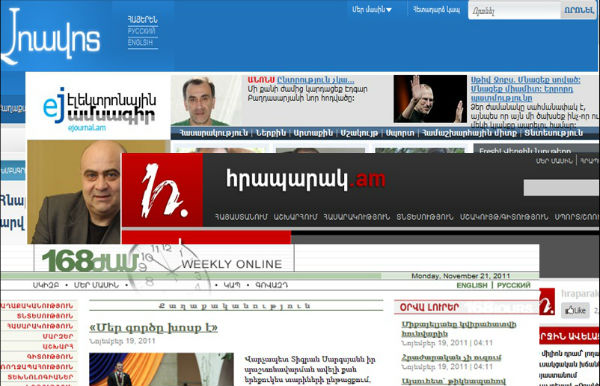To answer this question, in the first part of this article, we cited examples of obviously biased, unbalanced news media so that we can identify those news outlets that are trying to appear objective.
But before getting into that, let’s clarify something: by saying that H1 (Armenia’s Public TV), Kentron, Yerkir Media, and the others are not objective, we don’t mean that completely absent from these agencies is objective journalism with cultural, social and other issues.
Our hyper-politicized reality, when even issues not directly resulting from politics demand political solutions, forces us to view the field from this perspective. The noted news outlets are not objective because they clearly display their political “sympathies”; to put it differently, we mean the news outlets’ policies and not this or that piece by reporters working in these news agencies.
There are numerous news outlets in the field that don’t clearly display their political sympathies because they don’t have them or because it’s not beneficial to them to display them. If we call up those news outlets and ask them where their political sympathies lie, they will unanimously claim they don’t have “sympathies,” and their paper doesn’t serve the interests of this or that political entity and is objective.
The list of these types of news outlets is long, but let’s cite a few examples: 168 Zham (“168 Hours”), Aravot, Hraparak, Elektronayin Amsagir (“Electronic Monthly”) and so on.
Published on the print and online pages of such publications are critical articles addressed to both the opposition and the ruling authorities. Sometimes contradictory views can appear in these newspapers.
Not discussing the quality of “objectivity” in these news outlets, let’s note that they disseminate “impartial and balanced” news. Here, the matter could be considered closed, if there wasn’t the serious discrepancy in the balance demanded by readers and that offered by such news outlets.
Objective News, Subjective Funds
In Armenia, newspapers are purchased and read basically by people who have pro-opposition views, who are displeased with the country’s economic, social, and cultural state. The objective reality of the country is such that it’s actually difficult to fall into exaggeration whilst criticizing the government.
Appearing in the National Assembly, in gross violation of the Constitution, are major businessmen, nicknamed local district authorities who are named in criminal cases; they are appointed regional governors; the deputy defense minister is awarded the position of police chief; and the number of those leaving the country this year has reached 80,000.
In this situation, the government’s view doesn’t interest the reader. If she want that viewpoint, she’ll turn on the television.
Buying the paper are basically those who don’t believe the Armenia depicted by Haylur TV and want to read in the newspaper’s pages what their eyes have seen. They want to be informed of all that which won’t be broadcast on television. The reader wants a different opinion and pays for it by buying this other opinion in the paper.
It’s no coincidence that nearly all the newly launched newspapers, that more or less want to be financially independent, begin their activities as hard-lined opposition press, criticizing the government left and right, until they acquire a certain circle of readers only after which they begin to gradually become “objective.”
Newspaper publishers know how strong the power of habit is. A significant portion of those who’ve been buying a newspaper for a few months or even a few years will continue to buy the paper, even if they notice that it has changed its pro-opposition nature.
Nevertheless, the number of readers severely drops with the absence of sharp criticism from an oppositional stance.
There was a time when I wanted to publish a paper and I had a chance to call a few printing houses and make some calculations to find out at what quantity of consumption this business might be profitable. Based on my rough calculations, we’re talking about a print run of at least 4,000, whilst most Armenian papers have a print run of up to 3,500.
A significant portion of this print run — in the case of many papers, 60% or more — are not sold and are returned.
In order to be convinced, approach a few kiosks at the end of the day and ask how many copies of each paper they received and how many they sold. After going over a few kiosks, you’ll get the overall picture.
Now a question arises: with what means are newspapers that report “balanced” news published? Newspapers with small print runs don’t pose great interest for advertisers and can only be of interest to political parties or politicians.
I’m convinced that this is an indisputable fact for nearly all journalists in the media sector. Reporters from different “objective” news outlets even know which oligarch MP, political party or official is “supporting” their paper and toward whom they have to be more “objective” and “balanced.”
In the first part of this series we cited the example of Haykakan Jamanak (“Armenian Times”), which has a clear oppositional stance and it is due to this that it has relatively large circulation and sales. Haykakan Jamanak’s demand and financial self-sufficiently were also proven by the fundraiser the paper organized where it was able to gather more than 7 million drams in a few weeks.
After all this, one can conclude that a paper’s financial independence and the balanced news and freedom that stems from this are incompatible in Armenia’s reality.
Roughly speaking, there are subjective funds hidden beneath “objective” news media in Armenia. In the case of Armenia’s spasmodic reality, “to be balanced” has a certain price.
P.S. Perhaps distinguished in this sector are online news media financed by various international foundations, but that is already a subject for another article.
Hambardzum Hambardzumyan






